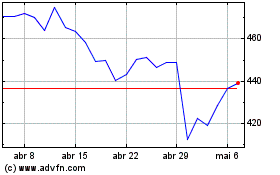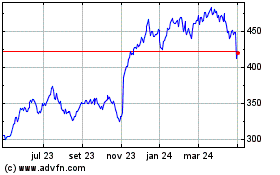Analysts Explore Industry Trends at Gartner
IT Symposium/Xpo 2024, October 21-24
Gartner, Inc. today announced its list of 10 top strategic
technology trends that organizations need to explore in 2025.
Analysts presented their findings during Gartner IT Symposium/Xpo,
taking place here through Thursday.
“This year’s top strategic technology trends span AI imperatives
and risks, new frontiers of computing and human-machine synergy,”
said Gene Alvarez, Distinguished VP Analyst at Gartner. “Tracking
these trends will help IT leaders shape the future of their
organizations with responsible and ethical innovation.”
The top strategic technology trends for 2025 are:
Agentic AI Agentic AI systems autonomously plan and
take actions to meet user-defined goals. Agentic AI offers the
promise of a virtual workforce that can offload and augment human
work. Gartner predicts that by 2028, at least 15% of day-to-day
work decisions will be made autonomously through agentic AI, up
from 0% in 2024. The goal-driven capabilities of this technology
will deliver more adaptable software systems, capable of completing
a wide variety of tasks.
Agentic AI has the potential to realize CIOs’ desire to increase
productivity across the organization. This motivation is driving
both enterprises and vendors to explore, innovate and establish the
technology and practices needed to deliver this agency in a robust,
secure and trustworthy way.
AI Governance Platforms AI governance platforms are
a part of Gartner’s evolving AI Trust, Risk and Security Management
(TRiSM) framework that enables organizations to manage the legal,
ethical and operational performance of their AI systems. These
technology solutions have the capability to create, manage and
enforce policies for responsible AI use, explain how AI systems
work and provide transparency to build trust and
accountability.
Gartner predicts that by 2028, organizations that implement
comprehensive AI governance platforms will experience 40% fewer
AI-related ethical incidents compared to those without such
systems.
Disinformation Security Disinformation security is
an emerging category of technology that systematically discerns
trust and aims to provide methodological systems for ensuring
integrity, assessing authenticity, preventing impersonation and
tracking the spread of harmful information. By 2028, Gartner
predicts that 50% of enterprises will begin adopting products,
services or features designed specifically to address
disinformation security use cases, up from less than 5% today.
The wide availability and advanced state of AI and machine
learning tools being leveraged for nefarious purposes is expected
to increase the number of disinformation incidents targeting
enterprises. If this is left unchecked, disinformation can cause
significant and lasting damage to any organization.
Postquantum Cryptography Postquantum cryptography
provides data protection that is resistant to quantum computing
decryption risks. As quantum computing developments have progressed
over the last several years, it is expected there will be an end to
several types of conventional cryptography that is widely used. It
is not easy to switch cryptography methods so organizations must
have a longer lead time to ready themselves for robust protection
of anything sensitive or confidential.
Gartner predicts that by 2029, advances in quantum computing
will make most conventional asymmetric cryptography unsafe to
use.
Ambient Invisible Intelligence Ambient invisible
intelligence is enabled by ultra-low cost, small smart tags and
sensors which will deliver large-scale affordable tracking and
sensing. In the long term, ambient invisible intelligence will
enable a deeper integration of sensing and intelligence into
everyday life.
Through 2027, early examples of ambient invisible intelligence
will focus on solving immediate problems, such as retail stock
checking or perishable goods logistics, by enabling low-cost,
real-time tracking and sensing of items to improve visibility and
efficiency.
Energy-Efficient Computing IT impacts
sustainability in many ways and in 2024 the leading consideration
for most IT organizations is their carbon footprint.
Compute-intensive applications such as AI training, simulation,
optimization and media rendering, are likely to be the biggest
contributors to organizations' carbon footprint as they consume the
most energy.
It is expected that starting in the late 2020s, several new
compute technologies, such as optical, neuromorphic and novel
accelerators, will emerge for special purpose tasks, such as AI and
optimization, which will use significantly less energy.
Hybrid Computing New computing paradigms keep
popping up including central processing units, graphic processing
units, edge, application-specific integrated circuits,
neuromorphic, and classical quantum, optical computing paradigms.
Hybrid computing combines different compute, storage and network
mechanisms to solve computational problems. This form of computing
helps organizations explore and solve problems which helps
technologies, such as AI, perform beyond current technological
limits. Hybrid computing will be used to create highly efficient
transformative innovation environments that perform more
effectively than conventional environments.
Spatial Computing Spatial computing digitally
enhances the physical world with technologies such as augmented
reality and virtual reality. This is the next level of interaction
between physical and virtual experiences. The use of spatial
computing will increase organizations’ effectiveness in the next
five to seven years through streamlined workflows and enhanced
collaboration.
By 2033, Gartner predicts spatial computing will grow to $1.7
trillion, up from $110 billion in 2023.
Polyfunctional Robots Polyfunctional machines have
the capability to do more than one task and are replacing
task-specific robots that are custom designed to repeatedly perform
a single task. The functionality of these new robots improve
efficiency and provide a faster ROI. Polyfunctional robots are
designed to operate in a world with humans which will make for fast
deployment and easy scalability.
Gartner predicts that by 2030, 80% of humans will engage with
smart robots on a daily basis, up from less than 10% today.
Neurological Enhancement Neurological enhancement
improves human cognitive abilities using technologies that read and
decode brain activity. This technology reads a person’s brain by
using unidirectional brain-machine interfaces or bidirectional
brain-machine interfaces (BBMIs). This has huge potential in three
main areas: human upskilling, next-generation marketing and
performance. Neurological enhancement will enhance cognitive
abilities, enable brands to know what consumers are thinking and
feeling, and enhance human neural capabilities to optimize
outcomes.
By 2030, Gartner predicts 30% of knowledge workers will be
enhanced by, and dependent on, technologies such as BBMIs (both
employer-and-self-funded) to stay relevant with the rise of AI in
the workplace, up from less than 1% in 2024.
This year’s top strategic technology trends highlight those
trends that will drive significant disruption and opportunity for
CIOs and other IT leaders within the next 10 years. Gartner clients
can read more in the Gartner Special Report “Top Strategic
Technology Trends for 2025.”
About Gartner IT Symposium/Xpo Gartner IT
Symposium/Xpo is the world's most important gathering for CIOs and
other IT executives. IT executives rely on these conferences to
learn how to amplify the impact of the technology, insights and
trends shaping the future of IT and business. Follow news and
updates from the conferences on X using #GartnerSYM, and on the
Gartner Newsroom.
Upcoming dates and locations for Gartner IT Symposium/Xpo
include: October 28-30 2024 | Tokyo, Japan November 4-7
2024 | Barcelona, Spain November 11-13 2024 | Kochi,
India
About Gartner for Information Technology Executives
Gartner for Information Technology Executives provides actionable,
objective insight to CIOs and IT leaders to help them drive their
organizations through digital transformation and lead business
growth. Additional information is available at
www.gartner.com/en/information-technology.
Follow news and updates from Gartner for IT Executives on X and
LinkedIn using #GartnerIT. Visit the IT Newsroom for more
information and insights.
About Gartner Gartner, Inc. (NYSE: IT) delivers
actionable, objective insight that drives smarter decisions and
stronger performance on an organization’s mission-critical
priorities. To learn more, visit gartner.com.
View source
version on businesswire.com: https://www.businesswire.com/news/home/20241021276572/en/
Matt LoDolce Gartner matt.lodolce@gartner.com
Catherine Howley Gartner catherine.howley@gartner.com
Gartner (NYSE:IT)
Gráfico Histórico do Ativo
De Dez 2024 até Jan 2025

Gartner (NYSE:IT)
Gráfico Histórico do Ativo
De Jan 2024 até Jan 2025
